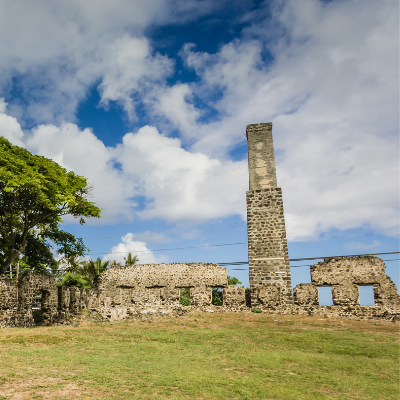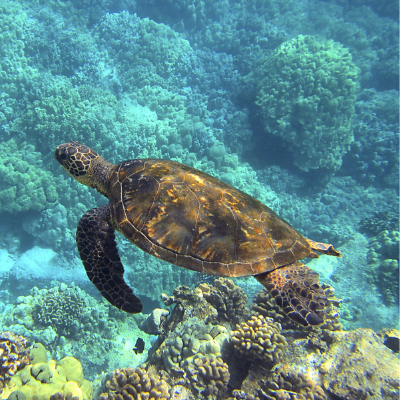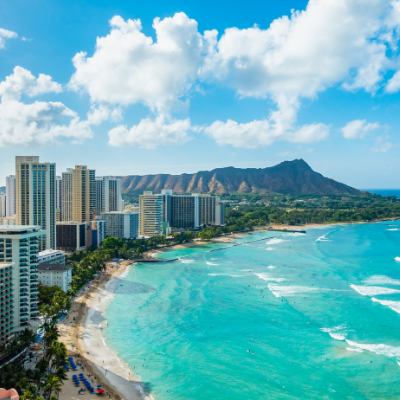Moving to Hawaii: Discover the Aloha State
This guide about moving to Hawaii is designed to help those who are in the early stages of researching where they’d like to move. Beautiful beaches, a rich culture, and delicious food. It’s no wonder why so many people love calling Hawaii home. According to 2020 Census data, Hawaii is growing, with a 7% increase in population since 2010. Is moving to Hawaii right for you? Read on and find out!

Important Things to Know about Hawaii’s Unique Geography
Hawaii sits about 2,000 miles from the United States mainland. Of the United States and comprises most of the Hawaiian archipelago (chain of islands). The Hawaiian archipelago is comprised of 137 volcanic islands and features eight major islands, several atolls (coral masses), small islets (teeny islands), and seamounts (underwater mountains / volcanos) that extend around 1500 miles in the North Pacific Ocean.
The eight major islands include: Hawai’I (The Big Island), Maui (the Valley Isle), O’ahu (The Gathering Place), Kaua’I (The Garden Isle), Moloka’I (The Friendly Isle), Lānaʻi (The Pineapple Isle), Niʻihau (The Forbbidden Isle), and Kahoʻolawe (The Target Isle).
Hawaii is the southernmost state and the second westernmost (after Alaska). It is the only state that is not geographically located in North America, the only state completely surrounded by water, and the only state that can grow its own coffee!
The islands were formed by volcanic activity from a magma source known as the “Hawai’I hotspot”. This area is still active today and continues to build islands. The Big Island is the largest and youngest island in the chain and was built from 5 volcanos.
The tallest point in Hawaii is Mauna Kea, a dormant volcano located on The Big Island. Mauna Kea sits at 13,803 feet above sea level, but if you measure Mauna Kea from the its base under water, it would be taller than Mount Everest!

Moving to Hawaii Guide Hawaii’s Rich History
Approximately 1500 years ago, Polynesians arrived in Hawaii by boat, using only the stars to navigate them. They remained isolated from the rest of the world for at least 500 years. The first group of Europeans to arrive at the Hawaiian Islands were led by James Cook, a British explorer, in 1778. Within 5 years of Cook’s arrival, under the technology and guidance of the Europeans, Kamehameha I conquered and unified the islands for the first time, establishing the Kingdom of Hawaii in 1795.
Europeans and Americans continued to immigrate over to the islands, opening doors for new crops and trade opportunities, as well as new diseases. The House of Kamehameha remained in power until 1893, after an overthrow and coup led to the eventual treaty of annexation for Hawaii as a territory to the United States in 1898, with the official annexation in 1900. Hawaii formally joined the US as the country’s 50th state in 1959.
Today Hawaii remains the eighth smallest and the 11 least populated. However, thanks to its rich history and physical location, it has become a major melting pot. In fact, Hawaii ranks as one of the most diverse states in the US.

Moving to Hawaii’s Guide on the Hawaiian Climate
Hawaii offers a very blissful climate, with fairly consistent weather. In fact, one can make the argument that Hawaii has two seasons: summer (May to October) and winter (November to April). The average summer temperature is around 85° F and the average winter temperature I around 78° F. There are several different microclimates, depending on which island you plan to visit and where you are on that island. For example, Kaua’i is known as one of the wettest places on the planet. Mostly, if you plan on moving to Hawaii, you can expect to enjoy mild, tropical climates pretty much all year long.
While it is mostly sunshine and rainbows on the Hawaiian islands, the islands are still subject to a host of natural disasters to consider. The most important natural disasters that tend to hit Hawaii include wildfires, floods, landslides, volcanos, earthquakes, thunderstorms, hurricanes, and tsunamis. Residents will also notice vog, or “volcanic fog”, which is the hazy air that can hang over the islands when sulfur dioxide and other gasses mix with the air and moisture.

Moving to Hawaii Guide on Finding a Job in the Aloha State
Hawaii’s economy has been hit hard by the COVID-19 pandemic. From April through June 2020, the state’s unemployment rate rose to nearly 20%. The economy has steadily recovered since, with 2021 ending with a 6.6% unemployment rate. Hawaii is forecasted to be at a 4.5% unemployment rate by 2024, which is still significantly higher than the 2.5% unemployment rate the state saw from 2017-2019.
All said and done, your best bet for finding a job in Hawaii is to look at the state’s major employer industries: construction, government, and service. A vast majority of the state’s major employers are on the Island of O’ahu, the states most populous island. According to the 2020 U.S. Census, the median household income in the state of Hawaii is $83,102, putting the state at the 5th highest in the nation. A good thing, too, as the cost of living in the state of Hawaii is the highest in the United States. If you plan on moving to Hawaii, you may also want to consider remote employment as an option.

What’s the situation on buying alcohol in Hawaii?
Who wouldn’t want to pop open a bottle of champagne at the sight of the glorious Hawaiian sunsets? Individuals 21 years of age and older may purchase beer, wine, and liquor at grocery stores 7 days a week until 11PM. Most bars may serve alcohol until 2:00AM, while places with a cabaret license can serve alcohol all the way until 4:00AM.

What is there to do in Hawaii?
Hiking, water sports, culture, and more – Hawaii has it all! Each of Hawaii’s islands offer their own special set of things to do. From touring and hiking the Nā Pali Coast to driving the Road to Hana to exploring volcanos, the natural beauty of Hawaii will take your breath away every step of the way. Diamon Head State Monument is one of Hawaii’s most iconic geological features and is located on the island of O’ahu.
Those seeking adventures will have no shortage to pick from in Hawaii. From hiking the iconic Kalalau Trail to watching the sunrise at Haleakala, Hawaii will continue to inspire everyone who sets foot on any island. Hawaii also offers a plethora of wonderful museums and cultural treats for all to enjoy. Amid the beaches, trails, and cultural sights, you’re bound to stay busy after moving to Hawaii!

Important State Symbols in Hawaii
The state of Hawaii has over 20 different officially recognized symbols. A few of our favorites have been included here! Did you know the state of Hawaii has an officially recognized dance? Of course, it should come as no surprise to those even remotely familiar with Hawaii that the state dance is the hula! The state fish is quite a mouthful – and boy do we mean it: Humuhumunukunukuapua`a. The Humuhumunukunukuapua`a is also known as the rectangular trigeger fish or Hawaiian trigger fish. The state gem is black coral and state sport is surfing! Each major island has its own flower: Hawai’I -`Ç hi`a lehua, Maui – Lokelani, O’ahu- Pua `ilima, Kaua’i – Mokihana, Moloka’i- Pua kukui, Lana’i – Kauna`oa, Ni’ihau – Pä pä (allthough Laiki, and Kahelelani aredesignated as the official lei material), and Kaho’olawe – Hinahina ornative heliotrope.
Lesser Known FAQ about moving to Hawaii
Q: What is the capital of Hawaii?
A: The capital of Hawaii is Honolulu, located on the island of O’ahu. is Saint Paul. Honolulu is known for the famous Waikiki neighborhood and boasts a majority of the states population. If you’re looking for dining, nightlife, and shopping, check out this amazing city.
Q: How do Hawaii public schools rank nationally?
A: According to a study by US News, Hawaiian public high schools rank 17/50 in a national breakdown tracking state-by-state high school performance. While education quality can vary widely depending on where in the state you live, this report takes the weighted average of the state’s high school performance into consideration.
Q: What kind of taxes can you expect to pay in Hawaii?
A: Hawaiian income tax rate changes on a graduated scale depending on how much income you make. Those in the lowest income bracket will pay a tax rate of 1.4% to those in the highest will pay 11%. Property taxes in Hawaii rank among the lowest in the US, sitting at just 0.28%. While there is no state sales tax, there is a general excise tax that businesses pay on all activities, which is usually passed on to customer and ranges around 4.0% to 4.5%.
Q: What’s it like to vote in Hawaii?
A: You may vote in Hawaii if you are at least 18 years old and a registered voter. All registered voters will receive a ballot by mail. The ballot must be received by 7PM on Election Day to be counted. Voting service centers will be open to collect in person votes and same day registrations 10 days prior and on Election Day.
To register to vote in the state of Hawaii, you must be a U.S. Citizen, resident of Hawaii and at least 16 years old. Those who register between 16 and 17 years old will be automatically registered and mailed a ballot upon reaching 18 years of age.
Q: What are the rules for switching your driver’s license in Hawaii?
A: Anyone moving to Hawaii may switch their out of state drivers license on the island in which they reside. Each major island offers their own DMV licensing facilities and the rules vary depending on the island. While there are no timelines for switching your license, some islands will require a written and road test should you attempt to transfer an expired out of state license.
Q: When do you need to update your car plates in Hawaii?
A: Similar to the driver’s license, switching car plates varies depending on the island you move to. For example, if you have moved to Hawaii County and you moved from another state, you may transfer your vehicle registration to Hawaii. You will need to bring the last issued state certificate of registration, title, and submit a bill of landing or shipping receipt which shows the date you arrived. Your vehicle must pass a safety inspection and be incompliance with all Federal Motor Vehicle Standards.
Q: What’s it like driving in Hawaii?
A: Like most states, the driving conditions in Hawaii are very different in urban and rural areas. In addition to driving around an abundance of tourists in the city, Hawaiians may drive on rough terrain or steep hills. Hawaii, in a tie with Nebraska, ranked at number 29 as the state with the worst drivers in America.
Q: Does Hawaii have any walkable cities?
A: Who wouldn’t want to walk around the gorgeous islands of Hawaii? Hawaii offers very walkable neighborhoods on each island. The most “walkable” city is Honolulu, which also happens to have the most robust transit options available as well.

Is Hawaii the Right State for You to Move?
If you’re looking for beautiful scenery, rich culture, and delicious food, Hawaii may be for you! We sure love the idea of waking up to one of those beautiful Hawaiian sunsets and heading off to a hike! However, the lack of employment and high risk of natural disasters prove that while absolutely sensational, Hawaii isn’t perfect.
We’re curious to hear your thoughts! Does Hawaii fit the bill, or do you need to research other moving guides? Let us know by leaving a comment below?



